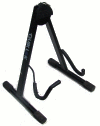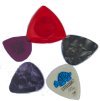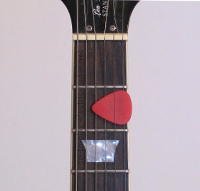Guide to Electric Guitar Accessories for Beginners
A few accessories and gadgets for electric guitar come in really handy for me, if you are a beginner you might not even know about some of them. In this article I explain what they are and how they can make your practice more productive and fun, as well as help you take care of your instrument.

Guitar groove lubricant - If you have a problem with guitar tuning stability when using the vibrato arm, lubricating the grooves in the guitar nut and bridge through which the strings pass will improve the stability a lot as well as reduce string breakages.
For more details on improving guitar tuning stability click here.

'GHS Fast Fret' string cleaner - this product prolongs the fingerboard and the string's life, and helps to glide your fingers faster around the fingerboard.

Guitar polish and cleaner - a handy accessory to safely remove fingerprints and dirt from the guitar finish and restore its lustre. I use 'Dunlop Formula 65'. with a micro-fiber polish cloth.

'Guitar Scratch Remover' - the remedy comes in handy if you scratched your guitar. It's effective and safe at removing scratches only on high gloss clear-coated factory finishes.
I posted my personal experience with the 'guitar scratch remover' and list of cases when not to use it on this page.

Chromatic guitar tuner - is the most comfortable and reliable way to tune your electric guitar in a noisy environment without making loud annoying sounds.
All you need to do is to plug your instrument directly into the tuner, pluck a string and the tuner's indicator will guide you in which direction you should turn a tuning peg on the guitar. See 'how to tune a guitar with a chromatic tuner' tutorial for more details on this.
Note that if you play through a digital effects processor, you probably already have a guitar tuner built in to it.
If you're going to buy a guitar tuner I recommend you to get 'Korg TM-50' model. This device also has a metronome functionality that is great for warm-up anywhere.
Another slightly expensive but a great tool is 'Korg Pitchblack true bypass tuner pedal'.
"True Bypass" means that you can integrate this tuner into your guitar effects chain and when it's off, the signal will run through it like through a piece of cable without affecting the sound of your instrument. With this integration you won't need to do extra plugging/unplugging.
The 'Hardwire HT-6 polyphonic tuner' is the most powerful device I've seen so far, it works like six tuners in one. When all the strings are strummed it shows the pitch of each string simultaneously, allowing you to instantly detect which ones are out of tune.

Guitar patch cable - this cable is used to connect guitar effects pedals. As opposed to a regular guitar cable, this one is very short, because you don't put effects pedals far away one from another and shorter cables introduce less induction noise.

Daisy chain power cord - this cord allows you to feed a number of guitar pedal effects using only one power supply. Note that your pedals should have the same voltage and polarity.

Electric guitar stand - this is one of the first things I recommend you to get with your guitar to make the placing comfortable and secure. Putting your instrument against the wall isn't a safe solution. The guitar can be easily knocked over and fall, scratching the finish or even worse, damaging or breaking the head or neck.

Guitar wall hanger - another type of a guitar stand that saves more space but requires drilling in your wall.

Guitar strap - the strap enables you to play in the standing position and also secures your guitar from falling when you're sitting.
If you don't have a strap yet, I recommend you to avoid buying the cheapest one and spend a few extra $ on a strap that has extra padding. I have used this kind of strap on my Les Paul guitar for a few years now and can say the extra padding feels a lot more comfortable and less tiring on the neck and shoulder.

Guitar picks - having picks with different hardness/thickness is important when you're a beginner, because you might discover that with a certain pick's gauge it's much more comfortable and easier for you to play, it's especially true if you replaced the strings to a new gauge.
It's also a good idea to have a bunch of picks. There's always a moment when you can't find your plectrum right when you want to play and this can be very irritating. Just have many of them in your storage place.

'Crossover Picks' - if you constantly switch between finger-style and picking the strings using a plectrum you might check out these picks as they can be firmly attached to your thumb, using a built in belt.

Pick holder - this little gadget provides a great deal of convenience, eliminating the need to look for your pick when you're wanting to play.
Makes sense to get if you're using more than one pick, otherwise you can always keep your single pick in the guitar strings like this:

A disadvantage of a standard pick holder is that it mounts on the guitar body with adhesive so when removed it can leave traces of the adhesive on the finish and blemish the looks of your instrument.
The 'Wedgie WPH001' pick holder is a good alternative to a regular one, it mounts on the strings just above the neck without any adhesive material.
Another glue free solution is to use the 'keychain pick holder'.

9v. 'One Spot' power supply - this DC adapter is specifically designed for guitar effects pedals and powerful enough to feed a dozen of them simultaneously through the daisy chain cord (see right above).
'One Spot' fits with Boss, Danelectro, Digitech - X series, DOD, EBS, Ibanez, Marshall, Zoom, Nobels, many Electro Harmonix, MXR pedals, Roland Micro Cube amp and a lot of others... Click here to read my personal experience with this adapter.

An informative book with an accompanying DVD on electric guitar choosing, setup, maintenance, troubleshooting (setting the intonation, action, solving the buzzing string sound and more); replacement of basic electronic components (pickups, switches, pots and capacitors).
This book has a great deal of useful tips and tricks to offer to a novice and can be used as a reference. Sure these days you can find many information on the internet, but still, it requires spending hours searching different pieces scattered about. having a bunch of expert tips all in one place is kind of handy.




